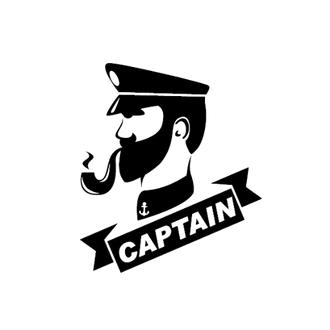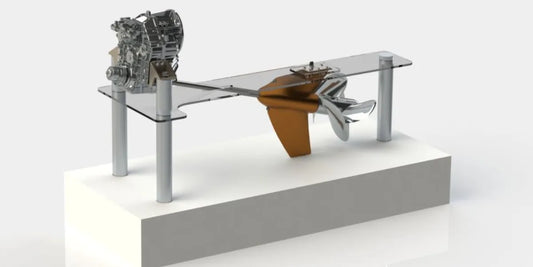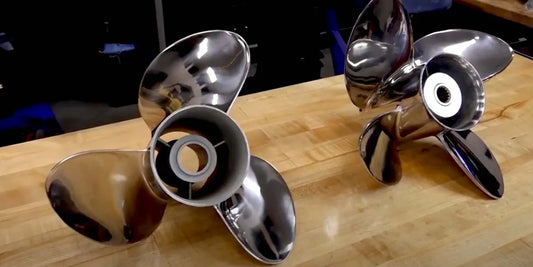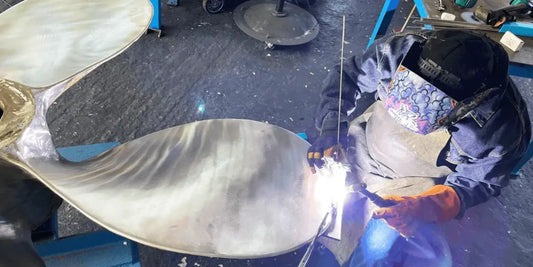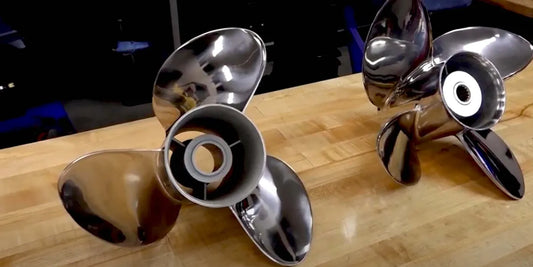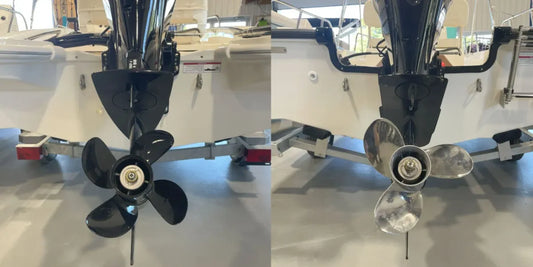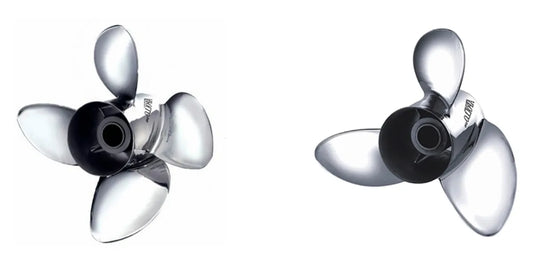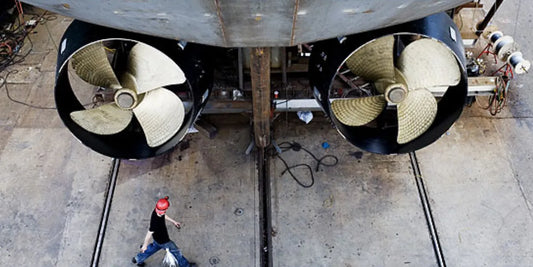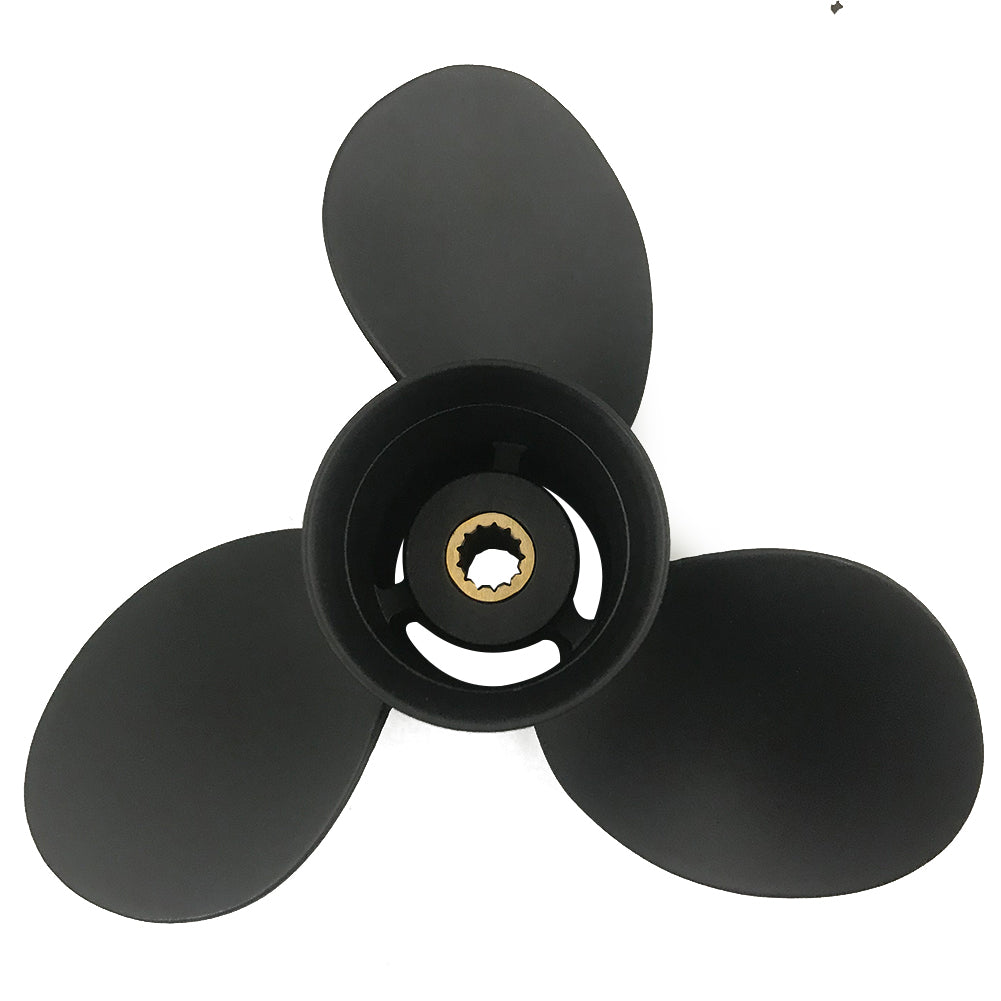The choice of changing into a 4-blade prop stands out as one of the finest performance-optimizing modifications that either the boater or serious mariner chooses, although there are many others built about speed, efficiency, or control. So, what about the 4-blade propeller-will it speed it up a little, or will it slow it down? Is it suitable for your needs? This article, therefore, examines how 4-blade propellers enhance speed, improve handling, and, consequently, increase overall propulsion efficiency. If you are interested in harnessing the full power of your vessel and want to stay ahead in performance optimization, keep reading to discover the scientific explanations and advantages of this upgrade.
Understanding Propeller Dynamics

What is a Propeller?
A propeller is a mechanical device designed to transform rotational motion into thrust for propelling a vessel or an aircraft through water or air. Generally, propellers are manufactured from stainless steel or aluminum and consist of blades arranged around a central hub. The design and angle of the blades are carefully chosen to ensure optimal performance, minimizing the drag force that acts against the motion of the vessels. The operation of a propeller rests on Newton's Third Law of Motion. Whenever the blades push a fluid (such as water or air) downward or backward, an equal and opposite reaction force is exerted on the craft, causing it to move forward.
Modern propellers are designed to achieve maximum propulsion efficiency, minimize vibration, and enhance durability. For instance, 4-blade propellers are becoming more common, as they give the best acceleration and steady handling in rough conditions. By selecting propellers based on their type, pitch, and material, depending on the specific application, you can achieve maximum performance with minimal power consumption.
How Blade Design Affects Performance
Blade design is the most critical feature in contributing to the final efficiency and, consequently, the operation of a propeller. The shape of the blades, the angle at which the blades cut through the surface, and the surface area of the blades all contribute to efficient propellers that interact with water or air. For example, thin blades with a precise angle of attack on high-performance propellers minimize drag at higher speeds.
Furthermore, due to advancements in hydrodynamics and aerodynamics, modern propellers can be designed with one of several blade curvatures or cup profiles. Each innovation will help reduce cavitation, improve energy transfer, and reduce vibrations during high-load operations. Some data indicate that a finely tuned blade design can increase efficiency by approximately 10-15%, potentially unlocking greater performance potential for marine and aircraft propulsion. Design options provide the engineer with a range of possibilities—a wide blade for increased lift and a thinner edge to reduce drag—which can be explored in search of the most optimized design without compromising strength.
Utilizing modern blade geometry and materials to enhance the design and performance of propellers enables propulsion systems to deliver superior performance, meeting the demands of industries that rely on highly efficient operations.
Comparing 3-Blade Versus 4-Blade Propellers
A choice between a 3- and 4-blade propeller usually depends upon performance characteristics, operational conditions, and vessel or aircraft-specific requirements. Each configuration possesses advantages that complement specific scenarios.
3-Blade Propellers: 3-blade propellers are usually preferred for a balance of performance and efficiency. Less drag is created with fewer blades, resulting in increased top-end speed and improved fuel efficiency. Where top-end speed and minimum fuel consumption are essential considerations, such as in lightweight powerboats or small aircraft, 3-blade designs do well. Another factor is that 3-blade propellers tend to be more cost-effective, as they require less complex manufacturing and fewer materials.
4-Blade Propellers: Conversely, 4-blade propellers are thought to work best when more thrust, better load-carrying capabilities, and smoother operations are needed. The increased blade area, which grips water or air more effectively, translates to finer handling and relatively better performance at lower speeds. Hence, attractive for boats requiring reliable acceleration with heavy load capability or rough-road performance, such as fishing boats, cruisers, or even turboprop aircraft. They can also reduce vibration levels, thus enhancing passenger comfort and the working life of equipment.
Key Differences and Applications
|
Feature |
3-Blade Propellers |
4-Blade Propellers |
|---|---|---|
|
Speed |
Higher top-end speed, less drag |
Slightly lower top-end speed due to added surface area |
|
Fuel Efficiency |
Better fuel economy, especially at cruising speeds |
Slightly reduced efficiency at higher speeds |
|
Thrust |
Lower thrust at slower speeds |
Higher thrust, particularly at lower speeds |
|
Handling |
Adequate maneuverability |
Improved handling in rougher conditions |
|
Comfort |
Moderate vibration levels |
Reduced vibration for smoother operation |
|
Applications |
Small craft, racing, lightweight aircraft |
Larger boats, fishing vessels, turboprops, utility craft |
When choosing between two designs, engineers and operators must consider operational requirements, the desired speed-thrust ratio, and environmental conditions. Both designs, utilizing modern materials and design methods, stand at the cutting edge of propulsion design, proving their worth in suitable applications.
The Benefits of Switching to a 4-Blade Prop

Improved Top Speed with 4-Blade Propellers
Four-blade propellers can enhance the top speed of a marine craft if an advanced marine engine with appropriate engineering optimizations is used to propel the vessel. An additional blade increases the total surface area, providing a better grip in the water and preventing slippage, thereby maximizing thrust efficiency. During the acceleration of high-performance boats, they maintain higher speeds even in adverse conditions, such as choppy waters or heavier loads.
Having considered the above functional aspects, newer designs incorporating stainless steel or advanced composites, along with improved aerodynamic & hydrodynamic characteristics, consequently produce top speeds with reduced weights. This enhances improvements for reducing cavitation effects, thereby allowing the propellers to sustain an extended operational duration without performance deterioration. Owners of speedboats and operators acknowledge the upgrade in speed and responsiveness when functions switch from 3-blade to 4-blade propellers.
The Acceleration Benefits of Four-Blade Propellers
From a performance perspective, 4-blade propellers offer greater acceleration and, therefore, are more suitable for boats that require crisp throttle response. The addition of the fourth blade increases the surface area, thereby allowing for better grip on the water and smoother acceleration, especially at low to medium speeds. Increased traction reduces slipping while delivering a nearly instantaneous power transfer from the engine to the propulsion.
For heavier loads and demanding water conditions, such as high waves and choppy seas, 4-blade props offer better reliability and smoother acceleration. According to research, boats with four-blade props can accelerate up to 10-15% faster than those with three-blade props, which is undoubtedly beneficial for watersports, commercial purposes, and scenarios requiring swift maneuvers. This balance between speed and stability is what makes the 4-blade technique so attractive to performance-oriented vessel operators.
Enhanced Control and Stability
The design of 4-blade propellers offers a certain finesse in handling and stability, particularly in challenging conditions such as rough waters or fast turns. The added blade increases the surface area in contact with the water, smoothing and balancing the operation. This stability is advantageous when towing wakeboarders or water skis, in which consistent handling and thrust are necessary. Furthermore, 4-blade propellers impart the ability to maintain a steady cruise speed irrespective of varying currents. Therefore, they remain a favorite amongst recreational and commercial boaters alike.
Modern onboard stability improvements also include cutting-edge propeller technology. Engineers reworked the blade geometry and pitch to place the force more efficiently, thereby reducing vibrations and cavitations, which could have detrimental effects on performance. Such an innovation makes for a very silent and comfortable ride, and operators handling large vessels or navigating crowded marinas feel assured. The precision engineering of 4-blade propellers ensures durability and performance, allowing vessel owners to control their crafts without sacrificing fuel economy or lifespan.
Choosing the Right Propeller for Your Boat

What to Consider: The 3-Blade vs. 4-Blade Controversy
When deciding between 3-blade and 4-blade propellers, understanding the performance characteristics of both will enable you to make an informed decision that aligns with your boating needs.
Speed and Efficiency: Generally, a 3-blade propeller can offer higher top-end speed and is more fuel-efficient in open water. As its surface area is much less, drag is much less; thus, if a boater is choosing speed instead of control, this prop should work. This style suits lighter vessels or any application where maximum speed is a priority.
Thrust and Control: These are ±4-thrust propellers, which operate at reservoir speed, providing somewhat better handling. Due to their additional blade, they have an even firmer grip on water, therefore offering the best control in rough conditions or with delicate maneuvers. This makes the 4-blade props suitable for towing, water skiing, and for bigger boats.
Cavitation and Smoothness: 3-blade propellers are prone to cavitation and thus the overall performance is abated when under heavy loading or during sharp turns. Whereas a 4-blade propeller arrests cavitation by applying pressure evenly over the wider surface, ensuring smooth movement and quieter sound.
Fuel Economy vs. Stability: 3-blade manufacturers advertise a higher fuel economy at speeds, whereas cost-wise, a 4-blade would be more beneficial when it comes to cruising at low speeds or maintaining even throttle levels. Likewise, 4-blade props provide extraordinary stability when the vessel gains speed, especially when the ship navigates rough waters or maneuvers in tight marinas.
Application and Load: Consider the typical loading and working conditions of your boat. A 3-blade prop fits well with pleasure boating or relatively light vessels; 4-blade variants work better for heavier loads, fishing trips, or activities that require greater precision and balance.
Ultimately, both designs have their merits, and the right choice may vary depending on the vessel's size, intended use, and water conditions. Otherwise, integrating modern advances in propeller manufacture with clear-cut performance requirements can make for a great boating experience. With proper maintenance and consultation with marine experts, one can ensure that their propeller will remain optimized for long-lasting performance and efficiency.
When to Choose a Four-Blade Prop
The 4-blade propeller is designed for boaters who seek more control, smoother handling, and improved performance in challenging conditions. They maintain speed well and cancel out vibration; hence, they are mainly used for towing activities such as wakeboarding or waterskiing. Having an extra blade for that prop means a lot more thrust and better handling when accelerating, which is important if you run a big boat or run one in rough waters.
Moreover, 4-blade props offer better thrust performance at low RPMs, resulting in improved fuel economy for cruisers and long-distance trips. Great cavitation fighters, they create a stable platform for the precise trolling speeds required by anglers. A little less top speed is sacrificed with 4-bladers. Still, on the other hand, they offer superior stability and load-carrying ability, plus fuel efficiency is essential for any boater seeking versatility and control. Of course, always check with your vessel's specifications and operational needs to arrive at a suitable conclusion regarding your boating needs.
Common Misconceptions About Blade Props
Another to be corrected is that blade props always perform better with more blades. More blades in a prop indeed increase smoothness by reducing vibration; however, the drag force is increased by the blades, which may hinder speed development. For example, the 4-blade propellers are promoted as better for control and towing, while a 3-blade propeller would be better for achieving higher top-end speeds. Depending on the type of boat used and the desired performance, the selection will vary from one to another.
Another misconception is that all propellers with the same diameter and pitch perform identically. The blade design, materials, and cup can drastically alter their performance. For example, even having the exact basic specifications, construction, and blade geometry, acceleration, fuel efficiency, and handling can all differ.
Some boaters also think that aluminum propellers are invariably inferior to stainless steel. The stainless steel prop enhances longevity and efficiency in high-performance applications, while the aluminum prop is considered an affordable and dependable option for recreational and moderate boating conditions.
Lastly, some believe prop optimization is unnecessary for newer boats. Even with modern vessel designs and innovations, the right choice of propeller is essential, whether for fuel economy, engine life, or simply achieving the stated performance. Having these misconceptions clarified and understanding the fine points of blade props can help boaters make a more informed decision based on their unique requirements.
Performance Testing: 3-Blade vs 4-Blade

Real-World Speed Comparison
Several factors go into the speed performance of 3- and 4-blade propellers. Usually, 3-blade propellers have higher maximum speeds since they produce less drag and weigh less. This usually makes them favorable among boaters who prefer maximum velocity on open waters. However, 4-blade propellers offer smoother handling and improved mid-range performance, making them ideal for boats that require stability in rough waters or while towing.
Generally speaking, various trials on different boat designs have shown that a 3-blade propeller reaches approximately 5-10% more speed at full throttle than its 4-blade counterpart. However, with such trade-offs, acceleration and fuel economy tend to side with 4-blade propellers. Furthermore, in adverse situations such as choppy seas, where accurate maneuvering counts, the lesser vibration from the 4-blade prop and increased grip significantly contribute to enhanced control.
Consequently, while the differentiating factors between the two tend to be performance issues, the choice mainly depends on what the boat stands for. Real-world speed comparisons must be analyzed in conjunction with hull-type-engine-power operationally oriented priorities to help the boater make an informed choice based on a set of considerations relevant to their situation.
Comparison of Acceleration: 3-Blade versus 4-Blade
How do you compare 3-blade and 4-blade propellers in acceleration performance? The main difference lies in how each design converts power into thrust. The 3-blade prop has an upper hand in quick acceleration, mainly due to its reduced water resistance. Less drag means the prop can turn faster with engine power, guaranteeing a faster throttle-up response time. This design is favored primarily in situations such as recreational boating or watersports, where acceleration time is a primary concern.
4-blade types present steadier acceleration curves. By an additional one, this one will grip better and push better, at least at low speed or high load. It is suitable for towing, such as towing wakeboarders or carrying loads. Additionally, in slightly rough conditions, this stability ensures consistent performance without sudden accelerator changes.
The differencing of the hydrodynamic efficiencies between the 3- and 4-blade propellers in question is situational: for a foremost feeling of rapidly reaching the front throttle, a sailor may instead go for 3 blades, while smooth, steady predominance under different conditions can find greater interest in an additional fourth.
User Experiences and Feedback
Several users have suggested that the performance difference between the 3-blade and 4-blade propellers depends mainly on the specific boating conditions and requirements. For individuals who prioritize speed and acceleration, a 3-blade propeller has been lauded for its ability to provide quick, responsive power, especially in open waters where efficiency is crucial. Conversely, the 4-blade propeller is praised by many who find themselves in rougher, more turbulent waters for maintaining stability and control particularly well when differential loading or towing activities are involved.
Recent discussions within the boating community have highlighted the growing need to balance fuel efficiency with performance. For example, some users emphasize that while a 3-blade setup can typically achieve higher top speeds, a 4-blade option may be more beneficial for fuel economy at cruising speeds. Real-life data appears to corroborate the argument, highlighting a dynamic that benefits in the long term by reducing operational costs while ensuring passengers enjoy a smooth ride.
Additionally, the feedback highlights the impact of new materials and design considerations on modern propeller construction. The use of advanced alloys combined with hydrodynamic engineering techniques now enables both 3-blade and 4-blade propellers to be more durable and less prone to cavitation, thereby providing users with consistent performance throughout their lifetime. These subtle insights refuse to leave users in the dark, allowing boaters to make informed decisions about which specifications work with their performance criteria and environmental conditions.
Conclusion: Maximizing Your Vessel's Performance

Some Final Words on the Selection of Propellers
Selecting the right propeller for your vessel is crucial, as it significantly impacts performance, efficiency, and stability. From the number of blades to materials and pitch, all these elements must be set according to your objectives as a boat owner. On the other hand, dealers say that considering these factors will result in smoother rides, better fuel efficiency, and durability that lasts over time. By putting in the effort upfront, your propeller will be elevating the vibration of your vessel rather than limiting it.
As far as I'm concerned, and before making any decision, I try to thoroughly understand the environment in which I intend to navigate and the activities I plan to pursue. Whether for cruising, towing, or watersports, the propeller should be designed and specified according to the demands of each scenario. For instance, a 3-blade prop excels in speed and efficiency, while a 4-blade offers good stability and handling at low speed. By matching those characteristics against my objectives, I am assured that I have considered everything to maximize my boating experience.
Propeller selection isn't uniform across the board. In collaboration, I study manufacturers' suggestions and public reviews, and, where feasible, take some for a test-drive. Whatever assumptions might apply to its performance when it strikes the water, I assess whether it has improved or deteriorated over time. With those considerations taken into account, it enables the chosen propeller to maximize the efficiency of your actual vessel and save future costs from scrutiny.
Boat Owner Recommendations
Boat owners, I think, should understand the needs of their particular boat and maintain a proactive approach toward maintenance and upgrades. First and foremost, ensure you know your boat’s engine specification, load capability, and typical uses before making any decisions concerning propeller selection or other modifications; all these factors affect how your boat operates under different conditions. From my perspective, the owner's manual and manufacturer sources form good points of reference when seeking recommendations for a particular boat model.
Secondly, regular inspections and maintenance are essential. I am in the habit of checking the condition of items of great importance whose everyday use involves interaction with water; I perform condition checks to ensure the props, anodes, and seals being received are not worn or damaged. Maintenance records will also help you quickly identify any recurring patterns or problems that can be addressed before they worsen. In addition to regular maintenance, frequent cleaning after each outing will prolong your boat's life and maintain its optimal condition, especially if you operate in saltwater.
Finally, you should seek advice from experts or fellow boaters. These local boating groups or internet forums have been a significant source of my learning. Whether it's sourcing the best products, troubleshooting technical difficulties, or just sharing experiences, these networks indeed save you time, money, and frustration. Boating isn't just about the destination; it's about the experience. Taking these steps ensures every trip is safe, fun, and productive.
Future Trends in Propeller Technology
In my opinion, innovation in efficiency and sustainability will remain a key aspect of propeller development in the future. Some exciting advancements being introduced include new materials such as carbon fiber composites. They make propellers lighter, stronger, and yet resistant to corrosion, thereby optimizing performance and fuel efficiency. The ability to use additive manufacturing or 3D printing enables designers to create more complex and customized propeller shapes, maximizing thrust and minimizing drag, resulting in enhanced overall performance.
Another trend that I see gaining importance is the focus on electric and hybrid propulsion systems. This is one of the trends that has cast its shadow on the propeller design landscape, leading to propellers intended to provide the best possible match with electric motors. These systems are quieter and greener, which fits nicely with the overarching theme of green technology. On the other hand, innovations such as variable-pitch propellers are being accepted, empowering operators to dynamically increase blade angles in certain conditions and reduce them in others for optimal performance.
Overall, I feel propeller technology will be one of the smarter, greener, and more adaptive solutions in the times to come. With AI- and IoT-enabled solutions, we will likely see the rise of self-regulating, sensor-equipped propellers that monitor conditions in real-time and make adjustments for optimal efficiency and safety. These trends will make boating easier and more efficient and, on the other hand, work in the direction of reducing our ecological footprint-a direction the industry has to move towards.
Reference Sources
-
3-Blade vs. 4-Blade Prop: What Are The Differences? - Reel Coquina Fishing
Discusses improved low-speed handling and maneuverability offered by 4-blade props. -
4 Blade vs 3 Blade Propeller - The Hull Truth
Highlights better pulling power at low speeds and quicker planing with 4-blade props. -
Will Switching to a 4-Blade Help Me Plane Out Faster? - iBoats Forum
Explains how 4-blade props provide more blade area, aiding in quicker and more stable planing. -
Typical Advantages and Disadvantages of Switching from 3 to 4 Blade Prop - The Hull Truth
List the advantages, such as quicker response times, fewer blowouts in turns, and improved performance in rough conditions. -
3 or 4 Blade Prop - Boat Talk - Ball of Spray
Explores how more blades reduce drag impact and maintain constant speed with better torque.
Frequently Asked Questions (FAQs)
Does it gain speed if fitted with a 4-blade propeller?
A 4-blade propeller may grant your boat a higher speed, especially at the lower RPMs. Here, with the increased number of blades, comes a greater blade area, which enables the ship to achieve better acceleration and maintain a better hold in the water. A 3-blade propeller might grant you more speed at the top-end; however, a 4-blade propeller would yield a better compromise between speed and efficiency. This serves predominantly in boats that choose to maintain cruise speed in adverse conditions. Yet, the effectiveness of this solution depends on the type of boat and the function that the existing propeller performs.
Advantages of a 4-blade over a 3-blade?
When a three or four-blade prop is considered, one significant advantage of the four-blading is that it produces more thrust; therefore, acceleration by a four-blade prop is better, making it more suitable when towing or in rough waters. Additionally, at cruising speed, a four-blade prop may be more fuel-efficient, as it induces less slippage, allowing a boat to perform better with less power, making it a popular choice among boaters. It ultimately depends on what your needs are and what your boat looks like.
How does the diameter of the 4-blade prop relate to its speed?
The diameter of a propeller with 4 blades determines the performance of the boat. A larger diameter would allow for more thrust and help the vessel reach plane altitude faster, thereby accelerating more quickly. A larger diameter means more drag, which counteracts top-end speed. Hence, the greater the mum diameter must be chosen for more speed and quicker efficiency. One should always consider the diametric pitch ratio, which ensures that the propeller cooperates with the engine's RPM and the throttle setting of the boat.
Can a 4-blade propeller give better mileage?
Yes, under certain conditions, a 4-blade propeller could indeed improve fuel efficiency. The more blades mean a larger surface area available for an efficient transfer of power to water. Due to this, the prop slip often ends up being lower, meaning that more power from the engine is directed into pushing the boat forward rather than just slipping through the water. Boaters, therefore, note that they can cruise at cruising speeds with lower throttle settings, further aiding fuel economy. However, such benefits of fuel economy will differ depending on the particular boat and the circumstances within which it is being operated.
Would the 4-blade propeller affect the boat's top speed?
Maximum speed can be altered with a 4-blade propeller. While many believe the 3-blade prop is always the one that can produce the most remarkable top speed, a 4-blade prop often provides better acceleration and handling. Having one extra blade can sometimes result in a reduction in top-end speed or drag at the highest RPMs. This compromise is certainly worth entertaining if one wants better low-end performance and efficiency. Consider your boat's specific needs, try different props, and determine which one is best for you.
What considerations should be made when choosing between a 3-blade and 4-blade prop?
When deciding between a 3- or 4-blade propeller, several factors must be considered. First: the type of boat and how it's used-the 4-blade prop would be better for cruising and towing. Second, consider the engine's RPM range and which prop type complements it best. A 3-blade prop provides better top speed, whereas 4-blade props focus on acceleration and fuel economy. Ultimately, one may want to seek advice from a prop specialist or consult propeller manuals to understand the implications of switching to a 4-blade prop.
